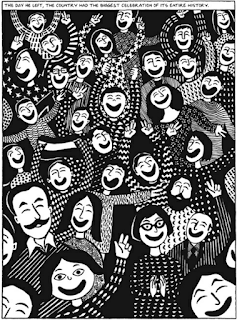To my readers I apologize in the lateness of this blog post.
I've been sick for the past week and a half with some sort of lung cold which
is still causing chest pains. I truly don't know why my lungs continue to ache.
I also apologize if today's content is shorter and briefer then usual.
Today I'm going to talk about graphic novel Persepolis. Like
Maus, it could be classified as a nonfiction graphic novel. It's style is easy
to understand, read, and follow. Written by Marjane Satrapi, it is an
autobiography about her childhood to her adult life.
It is very well written and easy to read. Now, there may be
some foreign elements of the story that could seem alien to most western
readers. I say most western readers, because I'm sure there's plenty of people
like myself who like to study other cultures for various reasons and as such,
transitioning between cultural texts is much easier than for most. But for
those who experienced culture shock easily, it may be a very unique experience.
One of the things that does stand out to me as an
interesting cultural reference that conflicts with Western culture, is the
initial view of communism and democracy in the novel. It shows communism in a
favorable light, while democracy is seen as unfavorable.
On this page we see her idolizing and dressing up as Che
Guevara and Fidel Castro. This may seem strange to a western audience,
especially an American audience. At one time in America, being called a
communist was about one of the most insulting things you could do to a person.
Actually, I think there’s still quite a few people who would take offense to
being called a communist. So for many Western readers, showing someone idolize prominent communist figures might seem an unthinkable premise.
Western readers might find this panel confusing.
I can imagine if the people of this country thought this is
the way democracy works, I can understand why they would be upset. I can't help
but wonder where this misinformation came from. These are just a small few
things the Western audiences might find strange.
There is one final thing I'd like to talk about before I stop, cuz
I'm still feeling quite unwell, this page.
I found that in Persepolis a good deal of weight is put into
the clothing in attire the characters wear. However, this page uses that to its
greatest effect, showing so much vibrancy and life in it's active pictures. But
not everything is cheerful in this picture. Scott McCloud said on page 132 of Understanding
Comics, “backgrounds can be another valuable tool for indicating invisible
ideas... Particularly the world of emotions”. The pitch black background gives
a sense of foreboding as if to say, “this happiness will not last forever”.
Well thank you all for reading and hopefully my cold has run
its course in time for the next blog post.
All images are from: The Complete Persepolis




Comments
Post a Comment